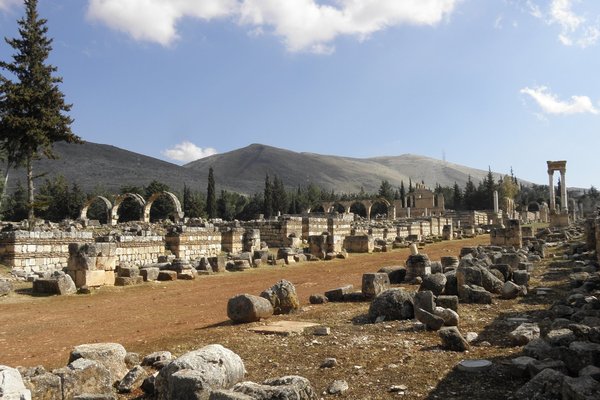Lebanon
Anjar
Anjar encompasses the ruins of an Umayyad trading city.
The city was founded in the early 8th century in a strategic location in the Bekaa Valley on the route between Baalbek and Damascus. It was abandoned and destroyed only some 40 years later. Its design was influenced by Roman urban planning and also shows the transition from protobyzantine styles towards Islamic art and architecture.
Community Perspective: its location close to the Syrian border and in the infamous Bekaa Valley has raised red flags over the past decades, but several reviewers made it there anyhow. It’s a low-key but interesting site that can be done as a day trip from Beirut, in combination with Baalbek.
Site Info
Official Information
- Full Name
- Anjar (ID: 293)
- Country
- Lebanon
- Status
-
Inscribed 1984
Site history
History of Anjar
- 1984: Inscribed
- Inscribed
- Type
- Cultural
- Criteria
- iii
- iv
Links
- UNESCO
- whc.unesco.org
- Official
-
- visit-lebanon.org — VisitLebanon
- Related
-
- archnet.org — Anjar in the Digital Library of ArchNet
- middleeast.com — Aanjar
All Links
UNESCO.org
- whc.unesco.org — whc.unesco.org/
Official Website
- visit-lebanon.org — VisitLebanon
Related Resources
- archnet.org — Anjar in the Digital Library of ArchNet
- middleeast.com — Aanjar
Community Information
- Community Category
- Archaeological site: Near Eastern
Travel Information
Red Zone Travel Advisory
Lebanon hotspot
Recent Connections
-
No Map
-
Perfect Inscriptions
1984 -
Red Zone Travel Advisory
Lebanon South and East
Connections of Anjar
- History
-
-
Umayyad Caliphate
OUV: “outstanding example of 8th century town planning of the Umayyad caliphate” and “... an eminent testimony, precisely dated, of the Umayyad civilization.” -
Silk Roads
Classic Land Route; in ICOMOS thematic study but no details on role or function
-
- Architecture
-
-
Mosaic art
At the baths
-
- World Heritage Process
-
-
No Map
-
First inscriptions
Lebanon: four inscriptions in 1984, with Anjar as the lowest number -
Perfect Inscriptions
1984
-
- Religion and Belief
-
-
Notable mosques
Umayyad Mosque
-
- Constructions
-
-
Baths
A hammam has been uncovered -
Tetrapylon
Ruins consist of a monumental tetrapyle (AB evaluation)
-
- WHS on Other Lists
-
-
Global Heritage Fund
Threat level: at risk -
U.S. Ambassadors Fund
Conservation of the 8th-Century Public Baths in the Umayyad City of Anjar (2010)
-
- Timeline
-
-
Built in the 8th century
Construction of the city started in 714
-
- WHS Hotspots
-
-
Lebanon hotspot
Lebanon Hotspot
-
- Visiting conditions
-
-
Foreigner prices
6000 Lebanese pounds for foreigners, 3000 for LebaneseSee www.mot.gov.lb
-
Red Zone Travel Advisory
Lebanon South and East
-
- WHS Names
-
-
Shortest WHS names
5 letters
-
News
No news.
Recent Visitors
Visitors of Anjar
- Afshin Iranpour
- Alexander Lehmann
- Ali Zingstra
- A. Mehmet Haksever
- Aspasia
- Atila Ege
- AYB
- Bill Maurmann
- Bin
- Boj
- Bram de Bruin
- Chantal den Haan
- Christravelblog
- Delphine Delaunay
- Dimitar Krastev
- Els Slots
- Erik Jelinek
- Errol Neo
- Eva Kisgyorgy
- Fan Yibo
- George Gdanski
- giloudepuertorico
- Hadrianus
- Harry Mitsidis
- henryjiao18
- Iain Jackson
- Ivan Rucek
- janem
- Jarek Pokrzywnicki
- Jeffrey Chai
- João Aender
- Joyce van Soest
- Juha Sjoeblom
- Ken DJ
- Knut
- Krijn
- Little Lauren Travels
- Loic Pedras
- Luis Filipe Gaspar
- Lukasz Palczewski
- Maciej Gil
- Malgorzata Kopczynska
- marcel staron
- Marcobrey
- Martina Rúčková
- Michael Novins
- michaelsballard
- Mikan22
- Milan Jirasek
- MMM
- Naim Y
- Nihal Ege
- palka25
- Persian Globetrotter
- PeterH
- Philipp Leu
- Philipp Peterer
- Randi Thomsen
- Rodinia
- Roger Ourset
- Roman Bruehwiler
- Sergio Arjona
- Stanislaw Warwas
- Svein Elias
- Szucs Tamas
- Tarquinio_Superbo
- Thomas Buechler
- Thomas van der Walt
- Timothy C Easton
- tony0001
- triath
- Vernon Prieto
- Walter
- Westwards
- Yongcheng Liu
- Zoë Sheng
Community Reviews
Show full reviews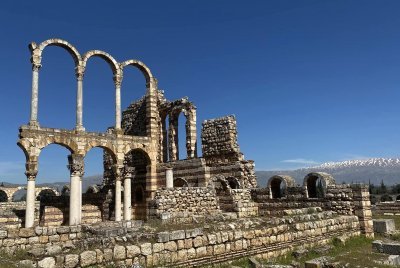
Visited April 2023.The first thing to understand is that Anjar is located on the Lebanese-Syrian border, a region controlled by Hezbollah, it adds additional instability. When I visited, the situation was calm, but this phenomenon is rare here, you have to watch for periods of peace.I was traveling from Beirut to Syria with a tourist group that was going to explore Syria, and I asked to see this object as well, the city is located exactly in the middle of the road between Beirut and Damascus. It is the legacy of the first dynasty of Umayyad caliphs. In Jordan, I saw palaces built by them in the desert, scientists argue about their function, and here it is not known exactly why this city was built.There is a real mix of cultures in Anjar, the general plan of a rectangular fortress with two large streets that intersect under the tetrapylon is borrowed from the layout of Roman military camps. At the same time, Byzantine masonry and decorative elements were used extensively, and thermal baths were borrowed from the Byzantines too.It is interesting that the city existed for a short time, about 40 years, and was completely abandoned when the Umayyads were defeated.
Keep reading 0 comments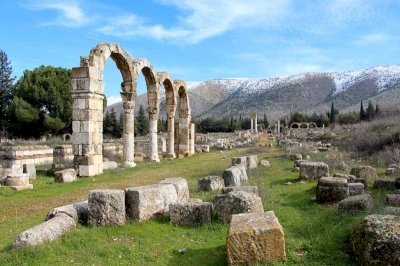
Visit: January 2019. I arrived in Anjar from Baalbek and had to rely entirely on my preloaded (I was not able to get mobile internet in Lebanon) Google Maps directions. I couldn’t find any signs pointing towards this WHS. Even within Anjar itself there is no clear signage. It is quite a shame how low key this place is, as in international comparison it is a very nice and deserving WHS.
Once arrived, there is free parking right in front of the entrance. Opening times are as generous as in most places around Lebanon (one more reason to like this country), so I didn’t have to worry about that.
The first thing I noted was that despite the moderate elevation drop of only 200m, Anjar was completely snow free, while Baalbek had been covered in a thick layer of snow. Unfortunately, the snow was replaced by mud, which made walking on parts of the site kind of a Super Mario hopping from stone to stone adventure. Nevertheless I really enjoyed this Umayyad town with the clear roman layout. The lack of safety standards means it’s no problem to walk on the city walls and explore parts of the town that are probably left out by the tour groups or maintenance. There were only four other tourists on site and one guy in the ticket booth. Plenty of unspoiled photo opportunities. Take your time to explore and you will find different districts for governing, housing, shopping and religion.
…
Keep reading 0 comments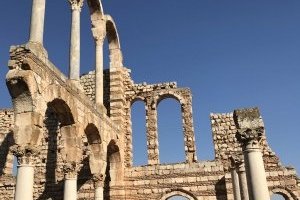
Even though Ivan and I both agreed Anjar is one of the less exciting world heritage sites of Lebanon, but given the overall impresiveness of the heritage of Lebanon overall, it means a lovely and a very interesting visit. You can go either by organized tours from Beirut, or just rent a car and drive yourself around all of Lebanese WHSs, though be careful, Lebanese are quite some drivers and not fond of using indicators. Anyway, Anjar lies in the Bekaa valley, about three kilometres away from the Syrian border. The population of the town is, as I've later learned, almost completely Armenian (they ran away here from the Armenian genocide of 1915).
The WHS is 8th century Umayyad town that has kept to the tradition of Roman city planning with two main streets perpendicular to each other. It's a lovely architectural park to walk around. There are info boards scattered around in English at important parts of the site. We made it around 10 a.m. on Saturday morning, along with a busload of European tourists, so the place was a bit crowded, so if you want to have it to yourself, arrive a bit earlier. But it's stil more off the beaten track, at least according to the Lonely Planet, which doesn't have Anjar listed at all. And from Anjar, follow on to the Baalbek. Not the other way around, Anjar will be a bit underwhelming.
Keep reading 0 comments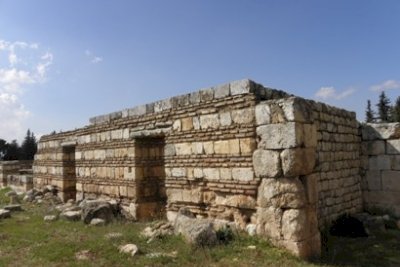
At turbulent times in recent Lebanese history, Anjar was a difficult site to visit. Even now, in the calm 2010s, the Dutch Ministry of External Affairs warns against going there. The site is located only a few kilometers from the Syrian border. It was used as a Syrian military base during its long involvement with the politics of neigbouring Lebanon. Everything was very quiet though when I visited in early April 2012. I guess the Syrians are too busy with themselves at the moment.
Having just visited Baalbek, Anjar comes across as a lesser example of Imperial Roman architecture. In fact, it is from a much later date, the 8th century: the engineers just used a lot of Roman and Byzantine examples. The most impressive is the strict layout of the city, with a north-south and an east-west axis. At the crossroads, there is a perfect example of a Tetrapylon.
The story here is that all small compartments along the axes were used as shops, hundreds of them. That would have made the city one huge shopping mall. I wonder where all the people came from who bought stuff here.
We spent about 45 minutes at Anjar archeological site (I was on a tour from Beirut). That was sufficient for me, it is mostly ruins that you can see. Besides our group of 6, a few other foreign individuals were visiting at the same time. The site is very low-key: it lies on the edges of the …
Keep reading 0 comments
We reached Anjar from Damascus coming from a round trip thru Syria in early April 2006. Anjar was our first WH site in Lebanon just a few miles from the Syrian border. It was particularely breathtaking seeing the snowtapped Lebanon heights forming the pitoresque background to the remains of the palace of Calif Walid.
Only 3 month later all TV news were showing the bombs on the very road we had just used. Similar barbarian acts jeopardized or even damaged the other lebanise WH sites. What a shame!
Keep reading 0 comments
